-

北师大初中数学九年级上册菱形的判定1教案
(1)求证:四边形BCFE是菱形;(2)若CE=4,∠BCF=120°,求菱形BCFE的面积.(1)证明:∵D、E分别是AB、AC的中点,∴DE∥BC且2DE=BC.又∵BE=2DE,EF=BE,∴EF=BC,EF∥BC,∴四边形BCFE是平行四边形.又∵EF=BE,∴四边形BCFE是菱形;(2)解:∵∠BCF=120°,∴∠EBC=60°,∴△EBC是等边三角形,∴菱形的边长为4,高为23,∴菱形的面积为4×23=83.方法总结:判定一个四边形是菱形时,要结合条件灵活选择方法.如果可以证明四条边相等,可直接证出菱形;如果只能证出一组邻边相等或对角线互相垂直,可以尝试证出这个四边形是平行四边形,然后用定义法或判定定理1来证明菱形.三、板书设计菱形的判 定有一组邻边相等的平行四边形是菱形(定义)四边相等的四边形是菱形对角线互相垂直的平行四边形是菱形对角线互相垂直平分的四边形是菱形 经历菱形的证明、猜想的过程,进一步提高学生的推理论证能力,体会证明过程中所运用的归纳概括以及转化等数学方法.在菱形的判定方法的探索与综合应用中,培养学生的观察能力、动手能力及逻辑思维能力.
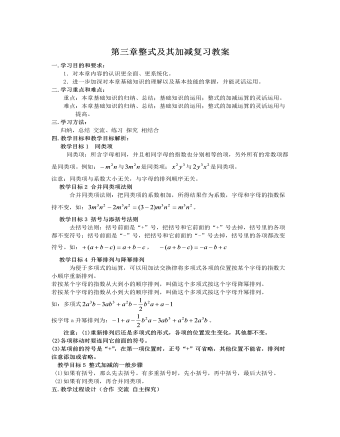
北师大初中七年级数学上册第三章复习教案
一.学习目的和要求:1.对本章内容的认识更全面、更系统化。2.进一步加深对本章基础知识的理解以及基本技能的掌握,并能灵活运用。二.学习重点和难点:重点:本章基础知识的归纳、总结;基础知识的运用;整式的加减运算的灵活运用。难点:本章基础知识的归纳、总结;基础知识的运用;整式的加减运算的灵活运用与提高。三.学习方法:归纳,总结 交流、练习 探究 相结合 四.教学目标和教学目标解析:教学目标1 同类项 同类项:所含字母相同,并且相同字母的指数也分别相等的项,另外所有的常数项都是同类项。例如: 与 是同类项; 与 是同类项。注意:同类项与系数大小无关,与字母的排列顺序无关。教学目标2 合并同类项法则 合并同类项法则:把同类项的系数相加,所得结果作为系数,字母和字母的指数保持不变,如: 。

北师大初中七年级数学上册第五章复习教案
16.已知甲组有28人,乙组有20人,则下列调配方法中,能使一组人数为另一组人数的一半的是( ).A.从甲组调12人去乙组 B.从乙组调4人去甲组C.从乙组调12人去甲组 D.从甲组调12人去乙组,或从乙组调4人去甲组17.足球比赛的规则为胜一场得3分,平一场得1分,负一场是0分,一个队打了14场比赛,负了5场,共得19分,那么这个队胜了( )场.A.3 B.4 C.5 D.618.如图所示,在甲图中的左盘上将2个物品取下一个,则在乙图中右盘上取下几个砝码才能使天平仍然平衡?( )A.3个 B.4个 C.5个 D.6个三、解答题.(19,20题每题6分,21,22题每题7分,23,24题每题10分,共46分)19.解方程:2(x-3)+3(2x-1)=5(x+3)20.解方程: 21.如图所示,在一块展示牌上整齐地贴着许多资料卡片,这些卡片的大小相同,卡片之间露出了三块正方形的空白,在图中用斜线标明.已知卡片的短边长度为10厘米,想要配三张图片来填补空白,需要配多大尺寸的图片.
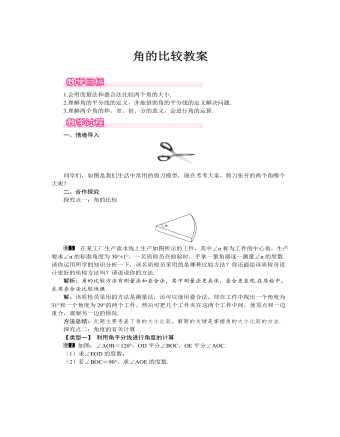
北师大初中七年级数学上册角的比较教案1
1.会用度量法和叠合法比较两个角的大小.2.理解角的平分线的定义,并能借助角的平分线的定义解决问题.3.理解两个角的和、差、倍、分的意义,会进行角的运算.一、情境导入同学们,如图是我们生活中常用的剪刀模型,现在考考大家,剪刀张开的两个角哪个大呢?二、合作探究探究点一:角的比较在某工厂生产流水线上生产如图所示的工件,其中∠α称为工件的中心角,生产要求∠α的标准角度为30°±1°,一名质检员在检验时,手拿一量角器逐一测量∠α的度数.请你运用所学的知识分析一下,该名质检员采用的是哪种比较方法?你还能给该质检员设计更好的质检方法吗?请说说你的方法.解析:角的比较方法有测量法和叠合法,其中测量法更具体,叠合更直观.在质检中,采用叠合法比较快捷.

北师大初中七年级数学上册绝对值教案1
方法总结:由绝对值的定义可知,一个数的绝对值越小,离原点越近.将实际问题转化为数学问题,即为与标准质量的差的绝对值越小,越接近标准质量.【类型四】 绝对值的非负性已知|x-3|+|y-2|=0,求x+y的值.解析:一个数的绝对值总是大于或等于0,即为非负数,若两个非负数的和为0,则这两个数同为0.解:由题意得x-3=0,y-2=0,所以x=3,y=2.所以x+y=3+2=5.方法总结:几个非负数的和为0,则这几个数都为0.三、板书设计绝对值相反数绝对值性质→|a|=a(a>0)0(a=0)-a(a<0)互为相反数的两个数的绝对值相等两个负数比较大小:绝对值大的反而小绝对值这个名词既陌生,又是一个不易理解的数学术语,是本章的重点内容,同时也是一个难点内容.教材从几何的角度给出绝对值的概念,也就是从数轴上表示数的点的位置出发,得出定义的.
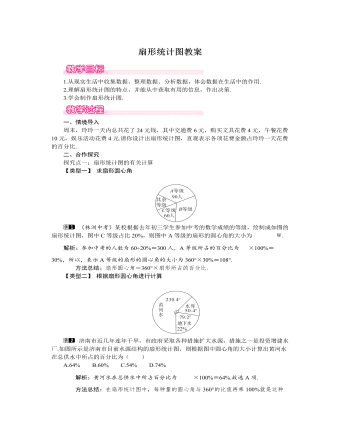
北师大初中七年级数学上册扇形统计图教案1
根据题意,得34%x-18%x=160,解得x=1000.所以48%x=48%×1000=480(公顷),18%x=18%×1000=180(公顷),34%x=34%×1000=340(公顷).答:玉米种了340公顷,高粱种了180公顷,水稻种了480公顷.方法总结:从扇形统计图中获取正确的信息是解题的关键.语文老师对班上学生的课外阅读情况做了调查,并请数学老师制作了如图所示的统计图.(1)哪种书籍最受欢迎?(2)哪两种书籍受欢迎程度差不多?(3)图中扇形分别表示什么?(4)图中的各个百分比如何得到?所有的百分比之和是多少?解:(1)科幻书籍最受欢迎,可从扇形的大小或图中百分比的大小得出.(2)科普书籍和武侠书籍受欢迎程度差不多,可从图中扇形大小或图中所标百分比的大小得出.(3)图中扇形分别代表了最喜欢某种书籍的人数占全班人数的百分比.(4)用最喜欢某种书籍的人数比全班的总人数即可得各个百分比,所有的百分比之和为1.方法总结:由扇形统计图获取信息时,一定要明确各个项目和它们所占圆面的百分比.
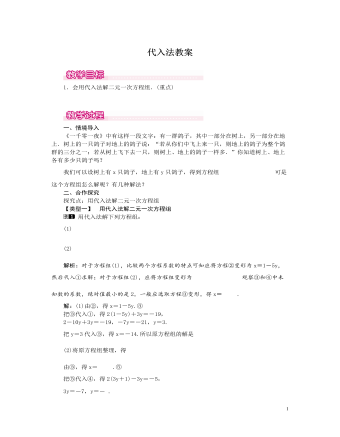
北师大初中数学八年级上册代入法1教案
【类型三】 已知方程组的解,用代入法求待定系数的值 已知x=2,y=1是二元一次方程组ax+by=7,ax-by=1的解,则a-b的值为()A.1 B.-1 C.2 D.3解析:把解代入原方程组得2a+b=7,2a-b=1,解得a=2,b=3,所以a-b=-1.故选B.方法总结:解这类题就是根据方程组解的定义求,即将解代入方程组,得到关于字母系数的方程组,解方程组即可.三、板书设计解二元一,次方程组)基本思路是“消元”代入法解二元一次方程组的一般步骤回顾一元一次方程的解法,借此探索二元一次方程组的解法,使得学生的探究有很好的认知基础,探究显得十分自然流畅.充分体现了转化与化归思想.引导学生充分思考和体验转化与化归思想,增强学生的观察归纳能力,提高学生的学习能力.
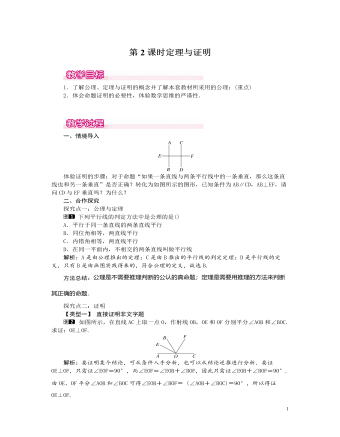
北师大初中数学八年级上册定理与证明1教案
求证:直角三角形的两个锐角互余.解析:分析这个命题的条件和结论,根据已知条件和结论画出图形,写出已知、求证,并写出证明过程.已知:如图所示,在△ABC中,∠C=90°.求证:∠A与∠B互余.证明:∵∠A+∠B+∠C=180°(三角形内角和等于180°),又∠C=90°,∴∠A+∠B=180°-∠C=90°.∴∠A与∠B互余.方法总结:解此类题首先根据题意将文字语言变成符号语言,画出图形,最后再经过分析论证,并写出证明的过程.三、板书设计命题分类公理:公认的真命题定理:经过证明的真命题证明:推理的过程经历实际情境,初步体会公理化思想和方法,了解本教材所采用的公理,让学生对真假命题有一个清楚的认识,从而进一步了解定理、公理的概念.培养学生的语言表达能力.
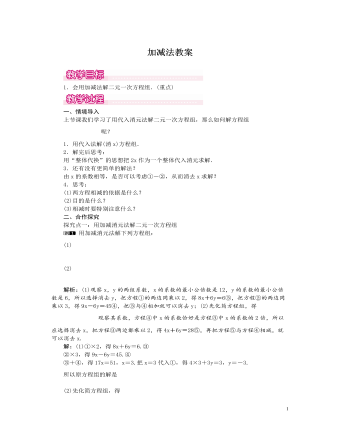
北师大初中数学八年级上册加减法1教案
已知xm-n+1y与-2xn-1y3m-2n-5是同类项,求m和n的值.解析:根据同类项的概念,可列出含字母m和n的方程组,从而求出m和n.解:因为xm-n+1y与-2xn-1y3m-2n-5是同类项,所以m-n+1=n-1,①3m-2n-5=1.②整理,得m-2n+2=0,③3m-2n-6=0.④④-③,得2m=8,所以m=4.把m=4代入③,得2n=6,所以n=3.所以当m=4,n=3时,xm-n+1y与-2xn-1y3m-2n-5是同类项.方法总结:解这类题,就是根据同类项的定义,利用相同字母的指数分别相等,列方程组求字母的值.三、板书设计用加减法解二元一次方程组的步骤:①变形,使某个未知数的系数绝对值相等;②加减消元;③解一元一次方程;④求另一个未知数的值,得方程组的解.进一步理解二元一次方程组的“消元”思想,初步体会数学研究中“化未知为已知”的化归思想.选择恰当的方法解二元一次方程组,培养学生的观察、分析问题的能力.
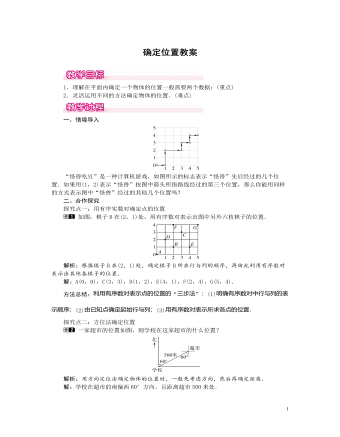
北师大初中数学八年级上册确定位置1教案
解析:要在地球仪上确定南昌市的位置,需要知道它的经纬度,故选D.方法总结:本题考查了坐标确定位置,熟记位置的确定需要横向与纵向的两个数据是解题的关键.【类型二】 用“区域定位法”确定位置如图所示是某市区的部分简图,文化宫在D2区,体育场在C4区,据此说明医院在________区,阳光中学在________区.解析:本题首先给出的是表示文化宫和体育场的位置,即D2区和C4区,这就确定了本题中表示建筑物位置的方法,即字母表示列数,数字表示行数.故填A3,D5.方法总结:解此类题先要弄清区域定位法中字母及数字各自表示的含义,再用已知的表示方法来确定相关位置.三、板书设计确定位置有序实数对方位法经纬度区域定位法将现实生活中常用的定位方法呈现给学生,进一步丰富学生的数学活动经验,培养学生观察、分析、归纳、概括的能力.教学过程中创设生动活泼、直观形象、且贴近他们生活的问题情境;另一方面,为学生创造自主学习、合作交流的机会,促使他们主动参与、积极探究.
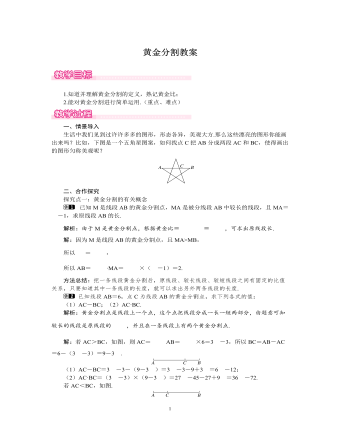
北师大初中数学九年级上册黄金分割1教案
解析:想要看起来更美,则鞋底到肚脐的长度与身高之比应为黄金比,此题应根据已知条件求出肚脐到脚底的距离,再求高跟鞋的高度.解:设肚脐到脚底的距离为x m,根据题意,得x1.60=0.60,解得x=0.96.设穿上y m高的高跟鞋看起来会更美,则y+0.961.60+y=0.618.解得y≈0.075,而0.075m=7.5cm.故她应该穿约为7.5cm高的高跟鞋看起来会更美.易错提醒:要准确理解黄金分割的概念,较长线段的长是全段长的0.618.注意此题中全段长是身高与高跟鞋鞋高之和.三、板书设计黄金分割定义:一般地,点C把线段AB分成两条线段AC 和BC,如果ACAB=BCAC,那么称线段AB被点 C黄金分割黄金分割点:一条线段有两个黄金分割点黄金比:较长线段:原线段=5-12:1 经历黄金分割的引入以及黄金分割点的探究过程,通过问题情境的创设和解决过程,体会黄金分割的文化价值,在应用中进一步理解相关内容,在实际操作、思考、交流等过程中增强学生的实践意识和自信心.感受数学与生活的紧密联系,体会数学的思维方式,增进数学学习的兴趣.
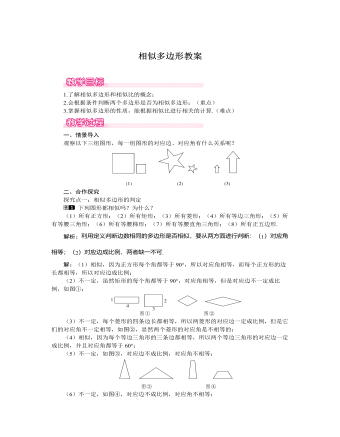
北师大初中数学九年级上册相似多边形1教案
(2)如果对应着的两条小路的宽均相等,如图②,试问小路的宽x与y的比值是多少时,能使小路四周所围成的矩形A′B′C′D′和矩形ABCD相似?解析:(1)根据两矩形的对应边是否成比例来判断两矩形是否相似;(2)根据矩形相似的条件列出等量关系式,从而求出x与y的比值.解:(1)矩形A′B′C′D′和矩形ABCD不相似.理由如下:假设两个矩形相似,不妨设小路宽为xm,则30+2x30=20+2x20,解得x=0.∵由题意可知,小路宽不可能为0,∴矩形A′B′C′D′和矩形ABCD不相似;(2)当x与y的比值为3:2时,小路四周所围成的矩形A′B′C′D′和矩形ABCD相似.理由如下:若矩形A′B′C′D′和矩形ABCD相似,则30+2x30=20+2y20,所以xy=32.∴当x与y的比值为3:2时,小路四周所围成的矩形A′B′C′D′和矩形ABCD相似.方法总结:因为矩形的四个角均是直角,所以在有关矩形相似的问题中,只需看对应边是否成比例,若成比例,则相似,否则不相似.

幼儿园大班数学活动说课稿 认识时钟
幼儿园数学是一门系统性、逻辑性很强的学科,有着自身的特点和规律,密切联系幼儿的生活,结合幼儿生活实际和知识经验来设计数学活动。时间无直观形象是较为笼统的因此,运用了幼儿较熟悉的一日活动的作息时间,引导幼儿认识整点、半点,如: 8 00 入园, 3 30 离园 … 这样易引起幼儿的情绪体验,为其理解和接受。根据教材内容和幼儿的实际情况,制订出本次活动的教学为:1 .使幼儿认识时钟,能叫出名称,基本掌握钟面的主要结构。2 使幼儿知道时针、分针、以及它之间的运转关系,能正确识别整点、半点。3 培养幼儿的观察力和操作能力,使幼儿建立初步的时间概念。
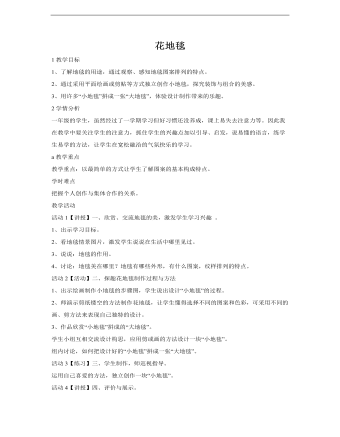
小学美术人教版一年级下册《第3课花地毯》教学设计
2学情分析一年级的学生,虽然经过了一学期学习但好习惯还没养成,课上易失去注意力等。因此我在教学中要关注学生的注意力,抓住学生的兴趣点加以引导、启发,说易懂的语言,练学生易学的方法,让学生在宽松融洽的气氛快乐的学习。a教学重点教学重点:以最简单的方式让学生了解图案的基本构成特点。学时难点把握个人创作与集体合作的关系。

人教部编版道德与法制五年级下册新版推翻帝制民族觉醒说课稿
2、班级交流请小组派代表在班级交流,说说在小组学习中的收获和体会。3、教师总结:孙中山先生一生都在为推翻帝制,推进民主革命,实现中华民族的伟大复兴而努力,他是一位伟大的革命先驱,值待我们每个人的尊敬与怀念。活动三:感受孙中山的革命精神(一)学习名言1、出示孙中山先生的名言,指名学生朗读。2、请学生来说说名言的含义。3、老师帮助解读,引导学生体悟孙中山先生的革命精神。4、请学生结合孙中山先生的伟大精神,说说对自己的学习生活的启示。5、齐读名言。(二)学习链接资料1、出示课文中链接资料,学生默读资料。2、讨论:说说我们国家目前的巨大变化,畅想祖国的美好未来。3、教师小结今日中华民族的伟大复兴与革命先辈们的不断探求救国救民之路,奋勇抗争推翻帝制是分不开的,让我们牢记历史,以孙中山等革命先驱为榜样,为祖国的美好未来努力奋斗!
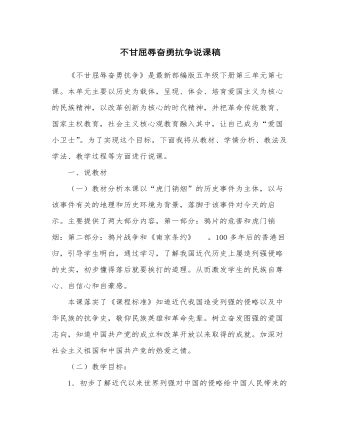
人教部编版道德与法制五年级下册新版不甘屈辱奋勇抗争说课稿
1、同学们,老师这里收到了一位法国大作家雨果的来信,让我一起来听一听。“在世界的一隅,存在着人类的一大奇迹,这个奇迹就是圆明园。圆明园属于幻想艺术。一个近乎超人的民族所能幻想到的一切都荟集于圆明园。只要想象出一种无法描绘的建筑物,一种如同月宫似的仙境,那就是圆明园。假定有一座集人类想象力之大成的宝岛,以宫殿庙宇的形象出现,那就是圆明园。”2、听了雨果的这段话,你脑海中的圆明园是怎么样的?有什么疑问吗?3、但是,这一奇迹现在已荡然无存,留在我们眼前的只有几根残缺的大石柱。它们静静地站在那里,像一座纪念碑,诉说那段屈辱的历史—板书:圆明园的诉说。二、学习新课,体验明理活动一:惊叹圆明园的辉煌师:圆明园是一座皇家园林,现在却只留下这些残垣断壁。那么,你知道圆明园在哪儿吗?你知道多少关于圆明园的故事?
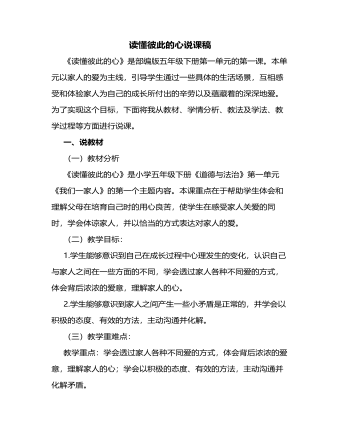
人教部编版道德与法制五年级下册新版读懂彼此的心说课稿
(二)理性面对:交流方式多。1、其实,遇到问题并不可怕,办法总比困难多。2.阅读王玉理的故事,你受到哪些启发?3.交流方式有很多:如写信、留言条等。4.情景出示:班里很多学生都可以用钢笔书写了,由于我写字漏字错字现象多,老师让我再练练,可是妈妈觉得是我写字写得不好。我认为这明明是两个问题,妈妈的误解让我很不开心。如果是你,你会怎么做呢?选择合适的方式,试着主动和妈妈交流沟通吧。(三)我爱家人:发现父母的美。1、小组内合作,阅读课前小调查“我眼中的父母别人眼中的父母”,说说有什么新的发同伴身上学现?2.列举事例说说父母身上的父母的闪光点,交流自己的感受。3.教师总结。(四)拓展延伸:布置活动作业。1.布置课后活动作业。2.小结:明确下节课学习内容。

人教部编版道德与法制五年级下册新版弘扬优秀家风说课稿
3.3百年革命家国情怀同学们,我们今天的美好生活,是许多烈士用鲜血换来的。书中摘录了一些仁人志士写给家人的书信。我们一起来读一读,边读边思考,你从中体会到了哪些优秀家风?热爱祖国,报效祖国。教师小结:在培育良好家风方面,先辈们为我们做出了榜样,让我们学习先辈,传承良好家风。4.活动园对长辈做一次访谈,了解家风,并在班中交流分享。(三)教师总结:家庭就像社会中的细胞,每一个小家的幸福共同构建起一个和谐的社会。每一个家庭的优秀家风,汇聚成中华民族的家风。无论时代如何变化,优秀家风都是国家发展、民族进步与社会和谐的基础。作业写作一篇《我的家风故事》,下节课分享讨论。五、说教学设计弘扬优秀家风优秀家风对个人成长、国家发展、民族进步和社会和谐的重要意义
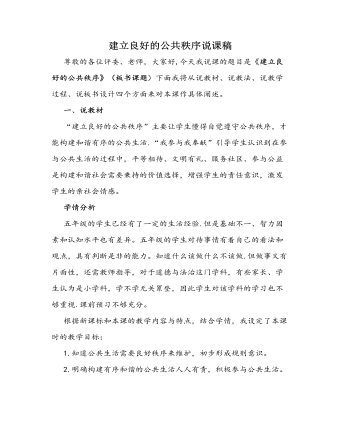
人教部编版道德与法制五年级下册新版建立良好的公共秩序说课稿
教师小结:同学们,通过刚才的讨论,我们明白了只有大家共同遵守规则,才能创造和谐文明的社会环境,正如著名学者莱蒙特所说的:“世界上的一切都必须按照一定的规矩秩序各就各位。”(六)、课堂总结师:通过今天对《建立良好的公共秩序》这一课的学习,我们懂得了什么?在生回答的基础上师进一步谈话:生活中有许多看起来是微不足道的事情,实际上都同社会的主产、生活乃至每个社会成员的工作、学习、生活密不可分,如果一个社会的公共秩序受到了破坏,这个社会的正常生产和生活也就受到极大的影响,社会风气就会颓败,反之如果一个社会的每个成员都学法、懂法、守法、护法,拥有一个良好的公共秩序,那么社会就会有条有理,井然有序,因此建立一个良好的社会公共秩序,是我们大家的迫切希望,希望同学们从我做起,从现在做起,认真遵守公共秩序吧!

人教部编版道德与法制五年级下册新版我们的公共生活说课稿
活动4:1.在你的周围有哪些常见的公共设施?它们各有什么功能?2.我们能为爱护公共设施做些什么?答案:1.常见公共实施:绿地、道路、路灯、地下(上)线路和管道停车场(库)、配电房(室)及电器设备、消防设备、电梯、健身娱乐设施公告牌等。功能:这些设施为人们提供了宜居的优美环境,为人们日常生活提供了方便,维护了人们正常的生活秩序,使人们的公共生活有了安全保障。2.我们要了解各类公共设施的功能和使用方法,爱惜使用各类公共设施,不损坏公共设施;自觉参与维护公共设施的活动,主动护理公共设施3.爱护公共施的做法有哪些?①要了解各类公共设施的功能和使用方法,爱惜使用各类公共设施,不损坏公共设施;②自觉参与维护公共设施的活动,主动护理公共设施。

